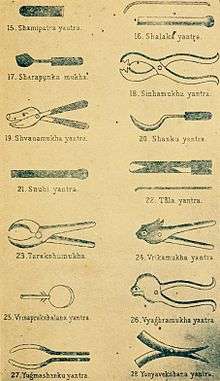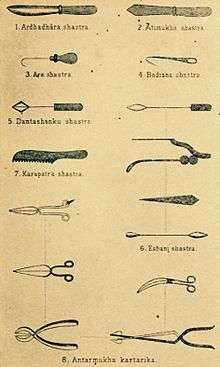Sushruta
Sushruta, or Suśruta (Sanskrit: सुश्रुत, IAST: Suśruta, lit. "well heard"[1]) was an ancient Indian physician known as the main author of the treatise The Compendium of Suśruta (Sanskrit: Suśruta-saṃhitā).[2] The Mahabharata, an ancient Indian epic text, represents him as a son of Vishvamitra, which coincides with the present recension of Sushruta Samhita.[3] Kunjalal Bhisagratna opined that it is safe to assume that Sushruta was the name of the clan to which Vishvamitra belonged.[4] He is one of a number of individuals described as the "Father of surgery" and "Father of Plastic Surgery".[5][6]
Sushruta | |
|---|---|
 A statue dedicated to Sushruta at Haridwar | |
| Born | Akhand Bharat |
| Known for | Author of Sushruta Samhita |
| Scientific career | |
| Fields | |
The Sushruta Samhita is one of the most important surviving ancient treatises on medicine and is considered a foundational text of Ayurveda.[7] The treatise addresses all aspects of general medicine, but the translator G. D. Singhal dubbed Suśruta "the father of surgery" on account of the detailed accounts of surgery to be found in the work.[8]
The Compendium of Suśruta locates its author in Varanasi.
Date
The early scholar Rudolf Hoernle proposed that some concepts from the Suśruta-saṃhitā could be found in the Śatapatha-Brāhmaṇa, which he dates to the 600 BCE,[9] and this dating is still often repeated. However, during the last century, scholarship on the history of Indian medical literature has advanced substantially, and firm evidence has accumulated that the Suśruta-saṃhitā is a work of several historical layers. Its composition may have begun in the last centuries BCE and it was completed in its present form by another author who redacted its first five chapters and added the long, final chapter, the "Uttaratantra." It is likely that the Suśruta-saṃhitā was known to the scholar Dṛḍhabala (fl. 300–500 CE), which gives the latest date for the version of the work that has come down to us today.[10] It has also become clear through historical research that there are several ancient authors called "Suśruta" who might be conflated.[10]
Citations
The Mahābhārata lists Suśruta amongst the sons of Viśvāmitra, the legendary sage.[11] The same connection with Viśvāmitra is also made in the Suśruta-saṃhitā itself.[12] The name Suśruta appears in later literature in the Bower Manuscript (sixth century CE),[13] where Suśruta is listed as one of the ten sages residing in the Himalayas.[13]
Suśruta-saṃhitā


The Suśruta-saṃhitā, in its extant form, in 184 chapters contains descriptions of 1,120 illnesses, 700 medicinal plants, 64 preparations from mineral sources and 57 preparations based on animal sources. The text discusses surgical techniques of making incisions, probing, extraction of foreign bodies, alkali and thermal cauterization, tooth extraction, excisions, and trocars for draining abscess, draining hydrocele and ascitic fluid, removal of the prostate gland, urethral stricture dilatation, vesicolithotomy, hernia surgery, caesarian section, management of haemorrhoids, fistulae, laparotomy and management of intestinal obstruction, perforated intestines and accidental perforation of the abdomen with protrusion of omentum and the principles of fracture management, viz., traction, manipulation, apposition and stabilization including some measures of rehabilitation and fitting of prosthetic. It enumerates six types of dislocations, twelve varieties of fractures, and classification of the bones and their reaction to the injuries, and gives a classification of eye diseases including cataract surgery.
References
- Monier-Williams, Monier (1899). A Sanskrit-English Dictionary. Oxford: Clarendon Press. p. 1237.
- "Modi was half-right: World's first plastic surgeon may well have been Indian (but he wasn't Shiva)".
- Bhishagratna, Kunjalal (1907). An English Translation of the Sushruta Samhita, based on Original Sanskrit Text. Calcutta: Calcutta. pp. ii(introduction).
- Bhishagratna, Kunjalal (1907). An English Translation of the Sushruta Samhita, based on Original Sanskrit Text. Calcutta: Calcutta. pp. ii (introduction).
- Champaneria, Manish C.; Workman, Adrienne D.; Gupta, Subhas C. (July 2014). "Sushruta: father of plastic surgery". Annals of Plastic Surgery. 73 (1): 2–7. doi:10.1097/SAP.0b013e31827ae9f5. ISSN 1536-3708. PMID 23788147.
- Sushruta: the father of Indian surgery and ophthalmology
- "When all of Indian food is obsessed with digestion, why are only Bengalis the butt of jokes?".
- Singhal, G. D. (1972). Diagnostic considerations in ancient Indian surgery: (based on Nidāna-Sthāna of Suśruta Saṁhitā). Varanasi: Singhal Publications.
- Hoernle, A. F. Rudolf (1907). Studies in the Medicine of Ancient India: Osteology or the Bones of the Human Body. Oxford: Clarendon Press. p. 8.
- Meulenbeld, Gerrit Jan (2002). A History of Indian Medical Literature. IA. Groningen: Brill. pp. 333–357. ISBN 9789069801247.
- कृष्णाचार्य, टी. आर्. (1910). "Sriman Mahabharatam. A New Edition Mainly Based on the South Indian Texts, with Footnotes and Readings". SARIT. Retrieved 10 January 2016.
- "Suśrutasaṃhitā. By Suśruta. A SARIT edition". SARIT. Retrieved 10 January 2016.
- Wujastyk, Dominik (2003). The Roots of Ayurveda. London etc.: Penguin. pp. 149–160. ISBN 978-0140448245.
External links
- Sutrasthana, Nidanasthana, Sharirasthana, Cikitsasthana, Kalpasthana, Uttaratantra: English translation, proofread, correct spelling, interwoven glossary